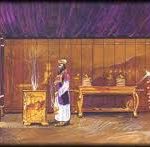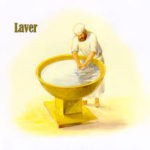Consecrating the Priest and Completing the Tabernacle Furnishings
We are almost through the instructions for God’s dwelling place among His people and the clothing for His priests. We have only traveled from Exodus 25 where the Tabernacle of God was first described! Sometimes while I review where we have been, I almost feel like we have actually helped with the preparation!! It seems to me, we have taken a long time to get where we are today! I hope you have enjoyed the journey as much as I have in researching and preparing the information. I always stand in awe of every detail our God gives so precisely! He truly is a God of details!!!
Special clothes were made for Aaron’s sons, also priests, and you can read the details in Exodus 28:40-43. Imagine being chosen to serve God for His chosen people! It was so important in Israel’s history that Exodus 29 is an entire chapter devoted to the details of consecration of the priests. “And this is what you shall do to them to hallow them for ministering to Me as priests: Take one young bull and two rams without blemish, and unleavened bread, unleavened cakes mixed with oil…” (Exodus 29:1-2) The actual consecrations don’t really take place until Leviticus 8. The sacrifices were significant: a bull for sin; one ram used for consecration and one for the wave offering and the heave offering. Consecration could not happen without shedding of sacrificial blood. Unleavened bread and cakes were for fellowship with God. All of the ceremony took place outside of the Tabernacle tent. (Sometimes it is confusing when we read the word Tabernacle. I have found that sometimes the word is used when talking about the tent with the Holy of Holies; and sometimes it is used to refer to the entire compound including the courtyard outside of the tent.)
In Exodus 25, we read about the Lampstand and the Showbread Table. But, that wasn’t all the furnishings that was in the Holy Place. The design for the Alter of Incense (Exodus 30:1- 10) was not given until the chapter after the instructions for consecrating the priests. “Perhaps, because it was the last piece to which the high priest came before he entered the Holy of Holies once a year. Right after Aaron’s consecration ceremony had been noted, his duties of (1) ensuring proper incense was offered continually upon this alter and (2) annually cleansing the alter with blood from the atonement offering (v.10) received attention .” (The MacArthur Bible Commentary page 126) The Alter of Incense was right before the Veil and between the Lampstand and the Showbread Table. The priest could not go past it on any other day than on the Day of Atonement. 
Every day there were two lambs sacrificed to God at the Alter of Incense; one each morning and one each evening, along with a “drink offering” which was “poured out” to God. Apostle Paul used the term “drink offering” to express his complete devotion to God. (Phil. 2:17) This priestly duty was continued into the New Testament and we read of it again in Luke 1, when Zacharias, the father of John the Baptist, was offering the morning sacrifice.
In Exodus 30:18-21, we find the instructions for the Laver of Bronze. “The washing of hands and feet was mandatory before engaging in priestly duties. The seriousness of being ceremonially purified is seen in the warning of death if this washing is neglected. Nothing casual was being done in the sanctuary or out in the courtyard.” (The MacArthur Bible Commentary page 127) This was located in the courtyard.
Exodus 30:22-33, “Nothing was left to chance or to human ingenuity. The ingredients for making the Anointing Oil were carefully spelled out. Using anything different was totally unacceptable and brought with it the penalty of death (v.33)” (The MacArthur Bible Commentary page 127)
When you read all of these precise instructions and warnings, do you feel like our church buildings today should be a place where there is ceremonial holy worship and a special reverence? I know that each of us is a “Tabernacle” today and that the Holy Spirit resides in each us instead of needing a building! I guess I still feel a closeness to the first Tabernacle and how very special it was to God. I stand in awe of His Grace He has given me and feel personally grateful to the point that I do want to show Him respect and holy reverence in the building where we meet to praise and adore Him! Perhaps that is just an individual decision to be made. I’m truly interested in how you feel about that!